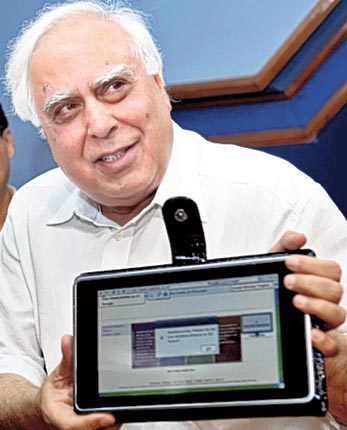India takes on the iPad with £23 touchscreen tablet for students

Your support helps us to tell the story
From reproductive rights to climate change to Big Tech, The Independent is on the ground when the story is developing. Whether it's investigating the financials of Elon Musk's pro-Trump PAC or producing our latest documentary, 'The A Word', which shines a light on the American women fighting for reproductive rights, we know how important it is to parse out the facts from the messaging.
At such a critical moment in US history, we need reporters on the ground. Your donation allows us to keep sending journalists to speak to both sides of the story.
The Independent is trusted by Americans across the entire political spectrum. And unlike many other quality news outlets, we choose not to lock Americans out of our reporting and analysis with paywalls. We believe quality journalism should be available to everyone, paid for by those who can afford it.
Your support makes all the difference.It looks like an iPad, only it's 1/14th the cost: India has unveiled the prototype of a £23 basic touchscreen tablet aimed at students, which it hopes to bring into production by 2011.
If the government can find a manufacturer, the Linux operating system-based computer would be the latest in a string of "world's cheapest" innovations to hit the market out of India, which is home to the 100,000 rupee (£1,380) compact Nano car and the 749 rupee water purifier.
The tablet can be used for word processing, web browsing and video-conferencing. It has a solar power option too – important for India's energy-starved hinterlands – though that will cost extra. "This is our answer to MIT's $100 [£65] computer," Human Resource Development Minister Kapil Sibal told The Economic Times when he unveiled the device yesterday.
In 2005, Nicholas Negroponte – co-founder of the Massachusetts Institute of Technology's Media Lab – unveiled a prototype of a £65 laptop for children in the developing world. India rejected that as too expensive and embarked on an effort to develop a cheaper option of its own.
Mr Negroponte's laptop ended up costing about £130, but in May his nonprofit association, One Laptop Per Child, said it plans to launch a basic tablet computer for £64.
Mr Sibal turned to students and professors at India's elite technical universities to develop the £23 tablet after receiving a "lukewarm" response from private sector players. He hopes to get the cost down to £6.50 eventually.
Mamta Varma, a ministry spokeswoman, said falling hardware costs and intelligent design make the price tag plausible. The tablet does not have a hard disk, but instead uses a memory card, much like a mobile phone. The tablet design cuts hardware costs, and the use of open-source software also adds to savings, she said. Ms Varma said several global manufacturers, including at least one from Taiwan, have shown interest in making the low-cost device, but no manufacturing or distribution deals have been finalised. She declined to name any of the companies.
India plans to subsidise the cost of the tablet for its students, bringing the purchase price down to about £13.
"Depending on the quality of material they are using, certainly it's plausible," said Sarah Rotman Epps, an analyst at Forrester Research. "The question is, is it good enough for students?"
The project is part of an ambitious education technology initiative by the Indian government, which also aims to bring broadband connectivity to India's 25,000 colleges and 504 universities and make study materials available online.
Join our commenting forum
Join thought-provoking conversations, follow other Independent readers and see their replies
Comments